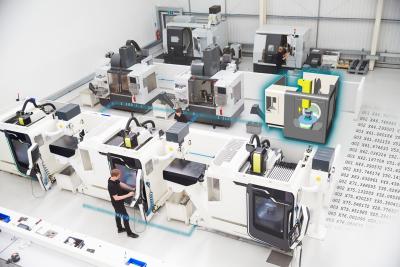
Continuing the ethos of powering a successful digital ecosystem that is smart and fully connected, Hexagon has released the latest NCSIMUL CAM simulation package from its Production Software portfolio.
It includes a number of important enhancements to both high-end machining verification and the module, which automatically converts CAM and NC programs to different machines. The three main topics that developers focused on in this latest release are:
- Optipower
- Interface enhancements
- 4CAM
Helping manufacturers bring their factories in line with the Industry 4.0 philosophy of smart production, NCSIMUL 2020.1 introduces an additional parameter to NCSIMUL Machine. Optipower complements the Optitool module by adding the necessary power and torque to remove material.
Technical Director Philippe Legoupi says it is used as a limitative parameter, which optimizes the program and limits power, so that risks of breakage are avoided. “It takes into account the type of material, the chosen tool, and the definition of its angles.” A graph shows the evolution of the power on the tool, so it can be limited to avoid possible flexions, overheating and premature deterioration.
The interface has been enhanced with two main developments which he says are particularly valuable for optimizing programs. “The aim is to save time through automated tools, and give a better and clearer view of work through enhanced navigation,” he says.
Firstly, a “graph window” has been added, enabling users to zoom in to focus on a specific tool rather than being restricted to a simple overview. “The choices are saved in the project window – so even if you need to watch another part of the program, the focus created on the chosen tool will be saved in the project. Also, the color of the focused graph matches the color of the toolpaths on the 3D view, which is helpful in giving a clear vision of the machining process at a glance,” Legoupi says.
Secondly, there is now the option of choosing a specific sequence in the arborescence. “By applying the F7 key, users can now reach the chosen place in the program, in the window they need. The milling sequence window is linked to the project tree, so it’s possible to navigate freely from one to the other. This is especially useful in switching quickly and simply from the program’s 3D view to the navigation tree, and vice versa,” he adds.
The 4CAM part of the digital twin solution benefits from enhancements including:
- Supports native polar toolpaths for mill-turn machines
- A new link for twin-head machines, and a change of rotation for safer positioning
General Improvements:
- Axis system duplication
- More realistic rendering without slowing the process
Overall, the NCSIMUL package builds an optimized virtual twin of the real-life machining environment to eliminate errors, secure production, decrease set-up times, reduce manufacturing costs, and increase shop-floor productivity.
Contact Details
Related Glossary Terms
- computer-aided manufacturing ( CAM)
computer-aided manufacturing ( CAM)
Use of computers to control machining and manufacturing processes.
- gang cutting ( milling)
gang cutting ( milling)
Machining with several cutters mounted on a single arbor, generally for simultaneous cutting.
- milling
milling
Machining operation in which metal or other material is removed by applying power to a rotating cutter. In vertical milling, the cutting tool is mounted vertically on the spindle. In horizontal milling, the cutting tool is mounted horizontally, either directly on the spindle or on an arbor. Horizontal milling is further broken down into conventional milling, where the cutter rotates opposite the direction of feed, or “up” into the workpiece; and climb milling, where the cutter rotates in the direction of feed, or “down” into the workpiece. Milling operations include plane or surface milling, endmilling, facemilling, angle milling, form milling and profiling.
- numerical control ( NC)
numerical control ( NC)
Any controlled equipment that allows an operator to program its movement by entering a series of coded numbers and symbols. See CNC, computer numerical control; DNC, direct numerical control.
